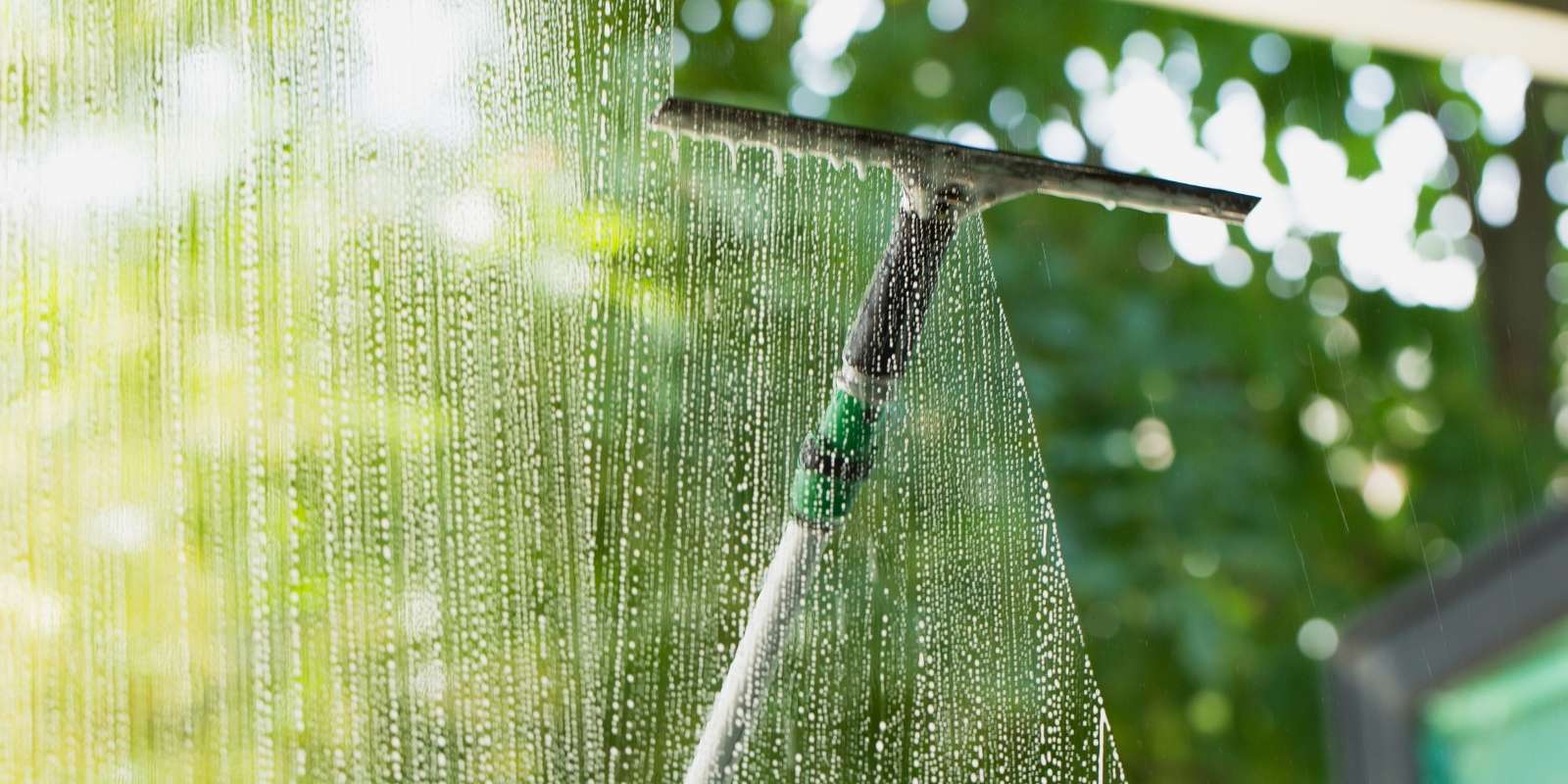Yes, you can power wash windows, but it requires careful handling to avoid damage. Power washing windows can be effective for cleaning external surfaces, especially if they are heavily soiled with dirt, algae, or grime. However, it’s essential to use the right pressure and techniques to prevent potential damage.
If you want to save the hassle, reach out to a professional power washing team like Vesta Property Pro today!
How To Power Wash Windows
Power washing windows can be an effective way to clean external surfaces, but it requires careful handling to avoid damage. Here’s a step-by-step guide on how to power wash windows safely and effectively:
Prepare the Area:
- Remove Obstacles: Clear any furniture, plants, or other items from around the windows to avoid damage.
- Cover Electrical Components: Use plastic sheeting or covers to protect nearby electrical outlets, light fixtures, and other sensitive areas from water.
Inspect the Windows:
- Check for Damage: Examine the windows for cracks or damage. Avoid power washing if the windows are already compromised.
- Ensure Proper Sealing: Confirm that the windows are properly sealed and closed to prevent water from seeping inside.
Choose the Right Equipment:
- Pressure Washer: Use a pressure washer with adjustable settings. A machine with a pressure rating between 1,000 and 1,500 PSI (pounds per square inch) is generally suitable for window cleaning.
- Nozzle Selection: Select a fan spray nozzle, preferably with a 25 to 40-degree angle. This will help disperse the water evenly and reduce the risk of damage compared to a direct stream.
Prepare Cleaning Solution:
- Detergent: Use a cleaning solution formulated for glass or windows. Avoid harsh chemicals that could damage the glass or frames.
Pre-Wet the Windows:
- Initial Rinse: Begin by lightly rinsing the windows with water to remove loose dirt and debris. This helps to prevent scratching the glass when you begin scrubbing.
Apply the Cleaning Solution:
- Choose The Right Soap:For pressure washing windows, use a specialized window cleaning detergent or a mild dish soap diluted with water. Avoid harsh chemicals or abrasive cleaners, as they can damage seals and glass. Eco-friendly and non-abrasive products are good options. Follow the manufacturer’s instructions for mixing and application to ensure effective and safe cleaning.
- Soap Application: Apply the cleaning solution to the windows using a low-pressure setting or a soap applicator. Allow the solution to sit for a few minutes to break down grime.
Power Wash the Windows:
- Use Controlled Pressure: With the fan spray nozzle, start washing from the top and work your way down. Maintain a consistent distance of about 2 to 3 feet from the glass to avoid high-pressure damage.
- Keep a Steady Hand: Move the wand in a sweeping motion, ensuring even coverage and avoiding focusing on one spot for too long.
Rinse and Check:
- Final Rinse: Rinse the windows thoroughly with clean water to remove any soap residue.
- Inspect: Check the windows for any remaining streaks or spots. If necessary, use a squeegee or clean cloth to remove residual water and achieve a streak-free finish.
Clean Up:
- Remove Covers: Take off any protective coverings from electrical components.
- Replace Items: Move furniture or plants back into place once the windows are dry.
Safety Tips:
- Always ensure that the ladder or scaffolding used is stable and properly positioned.
- Wear safety goggles and gloves to protect yourself from debris and cleaning solutions.
- Consider hiring professionals for multi-story buildings or difficult-to-reach windows to ensure safety and optimal results.
By following these steps, you can effectively power wash windows while minimizing the risk of damage and achieving a clean, streak-free result.
Can Pressure Washing Damage Window Seals?
Yes, pressure washing can potentially damage window seals if not done properly. Here’s how pressure washing might affect window seals and how to mitigate the risk:
- High Pressure: Using too high a pressure setting can force water into gaps between the window frame and the glass, potentially compromising the seal. This can lead to leaks or moisture infiltration.
- Direct Stream: A direct, high-pressure stream aimed at the edges of the window can cause damage to the seals. The force of the water can push against the seals, causing them to break down or become dislodged.
- Water Infiltration: If water gets under the window frame or into the seals, it can lead to problems like mold growth, rot, and deterioration over time.
To Avoid Damage:
- Use Low Pressure: Set the pressure washer to a lower PSI (typically between 1,000 and 1,500 PSI) and use a fan spray nozzle to gently clean the windows. This helps avoid forcing water into the seals.
- Maintain Distance: Keep the nozzle at a safe distance from the window to prevent high-pressure water from impacting the seals. Generally, maintaining a distance of 2 to 3 feet is recommended.
- Check Seals Regularly: Before starting the pressure washing, inspect the window seals for any existing damage or deterioration. Avoid pressure washing if you notice any issues with the seals.
- Professional Services: For best results, consider hiring professional pressure washing services. Professionals have experience handling delicate surfaces like windows and can use appropriate techniques and equipment to minimize the risk of damage.
Is It Cheaper To Power Wash Windows Myself?
Renting a power washer to clean your windows might seem like a cost-effective solution, but the expense is often comparable to hiring a professional. Additionally, using a power washer improperly can lead to costly damage. If the pressure is too high or the technique is incorrect, you could inadvertently crack or break your windows, resulting in repair or replacement costs that can run into the thousands.
To avoid these risks and ensure a thorough, damage-free job, it’s often more practical and economical to hire a professional power washing team. They have the expertise and equipment to get the job done right, saving you time, money, and the potential hassle of dealing with damage.
Takeaway
You can certainly power wash your windows yourself, but it’s essential to proceed with caution to avoid causing damage. Using a power washer on windows requires careful attention to pressure levels and technique.
Too high a pressure can force water into seals or cause the glass to crack. To mitigate these risks, set the pressure washer to a lower setting, maintain a safe distance from the glass, and use a fan spray nozzle.
Ensure you are familiar with the equipment and follow best practices for cleaning to protect your windows and achieve a satisfactory result. If you’re unsure or uncomfortable with the process, consider hiring a professional to ensure your windows are cleaned safely and effectively.









